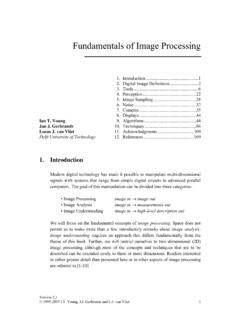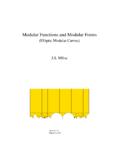Transcription of Digital Image Processing
1 Digital Image Processing Using MATLAB Second EditionRafael C. GonzalezUniversity of TennesseeRichard E. WoodsMedData InteractiveSteven L. EddinsThe MathWorks, Publishing A Division of Gatesmark, LLC of Congress Cataloging-in-Publication Data on FileLibrary of Congress Control Number: 2009902793 2009 by Gatesmark, LLCAll rights reserved. No part of this book may be reproduced or transmitted in any form or by any means, without written permission from the Publishing is a registered trademark of Gatesmark, LLC, is a registered trademark of Gatesmark, LLC, is a registered trademark of The MathWorks, Inc., 3 Apple Hill Drive, Natick, MA 01760-2098 The authors and publisher of this book have used their best efforts in preparing this book. These efforts include the development, research, and testing of the theories and programs to determine their effectiveness.
2 The authors and publisher shall not be liable in any event for incidental or consequential damages with, or arising out of, the furnishing, performance, or use of these in the United States of America10 9 8 7 6 5 4 3 2 1 ISBN 978-0-9820854-0-0 Gatesmark Publishing A Division of Gatesmark, LLC Digital Image Processing is an area characterized by the need for extensive ex perimental work to establish the viability of proposed solutions to a given problem. In this chapter, we outline how a theoretical foundation and state-of-the-art software can be integrated into a prototyping environment whose objective is to provide a set of well-supported tools for the solution of a broad class of problems in Digital Image Processing . BackgroundAn important characteristic underlying the design of Image Processing sys tems is the significant level of testing and experimentation that normally is re quired before arriving at an acceptable solution.
3 This characteristic implies that the ability to formulate approaches and quickly prototype candidate solu tions generally plays a major role in reducing the cost and time required to arrive at a viable system implementation. Little has been written in the way of instructional material to bridge the gap between theory and application in a well-supported software environment for Image Processing . The main objective of this book is to integrate under one cover a broad base of the oretical concepts with the knowledge required to im-plement those concepts using state-of-the-art Image Processing software tools. The theoretical underpin nings of the material in the following chapters are based on the leading text book in the field: Digital Image Processing , by Gon-zalez and Woods.
4 The software code and supporting tools are based on the lead ing software in the field: MATLAB and the Image Processing Toolbox R. C. Gonzalez and R. E. Woods, Digital Image Processing , 3rd ed., Prentice Hall, Upper Saddle River, NJ, 2008 .2 Chapter 1 Introductionfrom The MathWorks, Inc. (see Section ). The material in the book shares the same design, notation, and style of presentation as the Gonzalez-Woods text, thus simplifying cross-referencing between the two. The book is self-contained. To master its contents, a reader should have introductory preparation in Digital Image Processing , either by having taken a formal course of study on the subject at the senior or first-year graduate level, or by acquiring the necessary background in a program of self-study.
5 Familiar-ity with MATLAB and rudimentary knowledge of computer programming are assumed also. Because MATLAB is a matrix-oriented language, basic knowl-edge of matrix analysis is helpful. The book is based on principles. It is organized and presented in a text-book format, not as a manual. Thus, basic ideas of both theory and software are ex plained prior to the development of any new programming concepts. The ma terial is illustrated and clarified further by numerous examples rang-ing from medicine and industrial inspection to remote sensing and astronomy. This ap proach allows orderly progression from simple concepts to sophisticat-ed im plementation of Image Processing algorithms. However, readers already familiar with MATLAB, the Image Processing Toolbox, and Image Processing fundamentals can proceed directly to specific applications of interest, in which case the functions in the book can be used as an extension of the family of tool-box functions.
6 All new func tions developed in the book are fully documented, and the code for each is included either in a chapter or in Appendix C. Over 120 custom functions are developed in the chapters that follow. These functions extend by nearly 45% the set of about 270 functions in the Image Processing Toolbox. In addition to addressing specific applications, the new functions are good examples of how to combine existing MATLAB and tool-box functions with new code to develop prototype solutions to a broad spec-trum of problems in digi tal Image Processing . The toolbox functions, as well as the functions developed in the book, run under most operating systems. Consult the book web site (see Section ) for a complete list. What Is Digital Image Processing ?
7 An Image may be defined as a two-dimensional function, fxy(,), where x and y are spatial coordinates, and the amplitude of f at any pair of coordinates (,)xy is called the intensity or gray level of the Image at that point. When x, y, and the amplitude values of f are all finite, discrete quantities, we call the Image a Digital Image . The field of Digital Image Processing refers to Processing Digital images by means of a Digital computer. Note that a Digital Image is com posed of a finite number of elements, each of which has a particular location and value. These elements are referred to as picture elements, Image elements, pels, and pixels. Pixel is the term used most widely to denote the elements of a digi-tal Image . We consider these definitions formally in Chapter 2.
8 Vision is the most advanced of our senses, so it is not surprising that im-ages play the single most important role in human perception. However, un-like hu mans, who are limited to the visual band of the electromagnetic (EM) We use the term custom function to denote a function developed in the book, as opposed to a "standard" MATLAB or Image Processing Toolbox function. What Is Digital Image Processing ? 3spec trum, imaging machines cover almost the entire EM spectrum, ranging from gamma to radio waves. They can operate also on images generated by sources that humans do not customarily associate with images. These include ul trasound, electron microscopy, and computer-generated images. Thus, Digital Image Processing encompasses a wide and varied field of applications.
9 There is no general agreement among authors regarding where Image pro-cessing stops and other related areas, such as Image analysis and computer vi sion, begin. Sometimes a distinction is made by defining Image Processing as a discipline in which both the input and output of a process are images. We be lieve this to be a limiting and somewhat artificial boundary. For example, under this definition, even the trivial task of computing the average intensity of an Image would not be considered an Image Processing operation. On the other hand, there are fields, such as computer vision, whose ultimate goal is to use computers to emulate human vision, including learning and being able to make inferences and take actions based on visual inputs. This area itself is a branch of artificial intelligence (AI), whose objective is to emulate human in telligence.
10 The field of AI is in its infancy in terms of practical devel opments, with progress having been much slower than originally anticipated. The area of Image analysis (also called Image understanding) is in between Image process-ing and computer are no clear-cut boundaries in the continuum from Image Processing at one end to computer vision at the other. However, a useful paradigm is to consider three types of computerized processes in this continuum: low-, mid-, and high-level processes. Low-level processes involve primitive operations, such as Image preprocessing to reduce noise, contrast enhancement, and Image sharpening. A low-level process is characterized by the fact that both its inputs and outputs typically are images. Mid-level processes on images involve tasks such as segmentation (partitioning an Image into regions or objects), descrip-tion of those objects to reduce them to a form suitable for computer process-ing, and classification (recognition) of individual objects.



